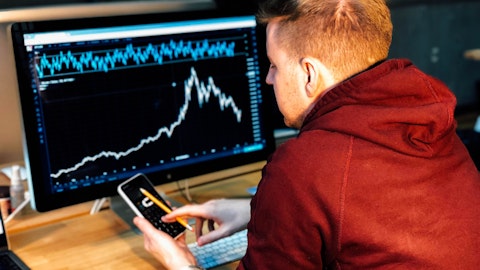In this piece, we will take a look at the 12 best German stocks to buy now. If you want to skip our overview of the German economy and how it has struggled as of late, then check out 5 Best German Stocks To Buy Now.
The outbreak of the Russian invasion of Ukraine upended the global energy markets, and one country that was caught smack in the middle was Germany. Germany is Europe’s largest economy in terms of output, and its manufacturing industry is made of some of the most well known car manufacturers in the world such as Bayerische Motoren Werke Aktiengesellschaft (OTCMKTS:BMWYY) and Volkswagen AG (OTCMKTS:VWAGY) which rely on cheap fuel to power up their manufacturing plants. The Russian invasion forced Europe to diversify its energy supplies away from Russia, and naturally, this increased costs for the companies since they had to source new energy for their needs.
In terms of numbers, Germany imported 42.6 billion cubic meters of gas from Russia in 2020, which accounted for 65% of its gas imports in the year. Naturally, this placed the German economy at quite a disadvantage when it came to replacing its energy sources, and the switching was a task that would have had painful outcomes for the Germans no matter how hard they tried to avoid them.
However, it’s been more than a year and a half since the invasion began and the situation is quite changed now. In fact, according to Germany’s finance minister Christian Linder, while Germany is still dependent on energy imports, these are not sourced from Russia. This alternative energy mix is made of coal fired power plants that were recommissioned once again, delayed its plans to shut down some nuclear power plants, and made investments to store more imported gas. The new strategy of increasing storage capacity is part of a global shift towards liquefied natural gas (LNG), which is simply natural gas compressed at extremely high pressures to make its storage and transportation easier since compressed gas allows for more volume of gas to be stored in a container. The uptick in LNG imports has spurred the Germans into action, and by May 2023 Germany had three new LNG terminals with a send out capacity of 2 billion cubic meters. In the LNG industry, send out is the amount of gas that a storage facility supplies to land based pipes, and the three new storage units have a capacity of 14 billion cubic meters.
The progress in expanding the LNG capacity continued after May as well, and in September 2023 the German gas operator Deutsche ReGas had booked 4 billion cubic meters of gas storage capacity for the next ten years at an island in the German Baltic Sea. These are floating storage and reception units (FSRUs), and the German government intends for them to serve as a stop gap measure before more fixed terminals can come online.
So, it’s clear that the Germans have moved fast to diversify their energy sourcing, but what about the impact on the German economy from all this disruption? Well, the picture isn’t too great for Europe’s largest economy when it comes to GDP growth. According to estimates from S&P Global’s HCOB German Flash Composite Purchasing Managers’ Index (PMI) shows that as of October 20th, the German economy remained in contraction. The four primary German PMI indicators, namely the Composite PMI Output, Services Activity, Manufacturing PMI Output, and Manufacturing PMI stood at 45.8, 48, 41.4, and 40.7, respectively. For the first two, the readings stood at two month low levels, while the latter two marked four month and five month highs, respectively. The report adds that business confidence remained low, and presented a sharp contrast between the manufacturing sector expectations and service sector expectations.
Reading into the data, the chief economist of Hamburg Commercial Bank, Dr. Cyrus de la Rubia, shared:
Germany is kicking off the final quarter on a sour note. The HCOB Composite Flash PMI is still stuck in the red this October and even slipped a notch from last month. Therefore, there is much to suggest that a recession in Germany is well underway. With the HCOB PMI indices baked into our GDP nowcast, we are calculating a -0.4 percent slip in GDP this quarter, after an estimated -0.8 percent slide the quarter before. If these nowcasts hit the mark, this would result in a -0.8 percent overall growth rate for 2023. This would make the German government’s -0.4 percent shrinkage call seem pretty rosy.
“The PMI results show that the downturn is broad based. Manufacturing output continues to fall at a steep rate and activity in the services sector, which grew last month, swung into the red again. The jobs market is mirroring the trend – services employment is in month two of a gentle decline, while manufacturing, already four months into staff cuts, just hit the gas on layoffs. However, the recent composite PMI employment index readings are still outshining those dreary levels of the 2001/2002 and 2008/2009 recessions.
“Input prices in the German services sector are continuing to rise at an unusual high rate. Increased energy prices and high wage pressures are most likely at the core of this development. Firms are still managing to roll some of those inflated costs onto the customer’s tab, and October did not see much change in that. Thus, there is no reason to pull the plug on inflation concerns.
“Looking for some glimmers of hope? Well, there are, especially in the manufacturing sector. The index of new orders, though at still low levels, has increased for the second month in a row and the output index has jumped above the 40 mark. Together with the increase in the index of stock of purchases, we take these developments as signs that there is some bottoming out happening in this sector. Manufacturing might return to growth territory in the early part of next year.”
So, while there’s turmoil in the German economy, the brave might be searching for some best German stocks. We compiled a list of German stocks today, with the top three picks being BioNTech SE (NASDAQ:BNTX), Immatics N.V. (NASDAQ:IMTX), and Deutsche Bank Aktiengesellschaft (NYSE:DB).

Photo by Jacek Dylag on Unsplash
Our Methodology
To compile our list of the best German stocks to buy, we first made a list of all German firms that are trading on the NASDAQ and NYSE exchanges. Then, those firms with the greatest number of hedge fund investors during Q2 2023, and the top German stocks are as follows.
12 Best German Stocks To Buy Now
12. Atai Life Sciences N.V. (NASDAQ:ATAI)
Number of Hedge Fund Investors In Q2 2023: 7
Atai Life Sciences N.V. (NASDAQ:ATAI) is a biotechnology company developing treatments for mental health disorders. Its shares are rated Strong Buy on average and analysts have priced in a $11 upside based on the average share price target of $12.32.
As of Q2 2023 end, seven out of the 910 hedge funds tracked by Insider Monkey had held a stake in the company. Atai Life Sciences N.V. (NASDAQ:ATAI)’s biggest shareholder among these is Israel Englander’s Millennium Management due to its $1.9 million investment.
Atai Life Sciences N.V. (NASDAQ:ATAI) joins Immatics N.V. (NASDAQ:IMTX), BioNTech SE (NASDAQ:BNTX), and Deutsche Bank Aktiengesellschaft (NYSE:DB) in our list of the top German stocks.
11. Lilium N.V. (NASDAQ:LILM)
Number of Hedge Fund Investors In Q2 2023: 8
Lilium N.V. (NASDAQ:LILM) is an aerospace firm that is designing electric aircraft that are capable of vertically taking off and landing. The firm had a major announcement for investors in October 2023, when it revealed that its jet had become the first of its kind to be available for sale in the U.S.
During this year’s second quarter, eight out of the 910 hedge funds profiled by Insider Monkey had invested in Lilium N.V. (NASDAQ:LILM). The firm’s largest hedge fund investor is Israel Englander’s Millennium Management as it owns 811,379 shares that are worth $1.4 million.
10. trivago N.V. (NASDAQ:TRVG)
Number of Hedge Fund Investors In Q2 2023: 9
trivago N.V. (NASDAQ:TRVG) is a travel services provider that allows organizations and individuals to search for hotels. A slowing economy and high inflation all over the world have not helped the firm at all, since it has missed analyst EPS estimates in all four of its latest quarters and the stock is rated Hold on average.
As of June 2023, nine hedge funds among the 910 tracked by Insider Monkey had bought the firm’s shares. trivago N.V. (NASDAQ:TRVG)’s biggest shareholder out of these is Paul Reeder and Edward Shapiro’s PAR Capital Management due to its $29.1 million stake.
9. MorphoSys AG (NASDAQ:MOR)
Number of Hedge Fund Investors In Q2 2023: 9
MorphoSys AG (NASDAQ:MOR) is a biotechnology company that is developing treatments for cancer and other immune system related diseases. Its shares have seen quite a bit of action in September and October, as Goldman Sachs and Morgan Stanley upgraded the rating from Sell and Underweight to Neutral and Overweight, respectively.
By the end of 2023’s second quarter, nine out of the 910 hedge funds polled by Insider Monkey had held a stake in MorphoSys AG (NASDAQ:MOR). James A. Silverman’s Opaleye Management owns the largest stake among these, which is worth $9 million.
8. Fresenius Medical Care AG & Co. KGaA (NYSE:FMS)
Number of Hedge Fund Investors In Q2 2023: 9
Fresenius Medical Care AG & Co. KGaA (NYSE:FMS) is a healthcare company that provides dialysis and other associated products and services. Its shares that are traded on the European ETR exchange are quite popular among institutional investors, who own more than 40% of the stock; lending it credibility, yet opening the risk of sudden price movements.
For their shareholdings during this year’s June quarter, nine hedge funds out of the 910 part of Insider Monkey’s research were the firm’s investors. Fresenius Medical Care AG & Co. KGaA (NYSE:FMS)’s biggest hedge fund shareholder is Richard S. Pzena’s Pzena Investment Management as it owns $398 million worth of shares.
7. InflaRx N.V. (NASDAQ:IFRX)
Number of Hedge Fund Investors In Q2 2023: 11
InflaRx N.V. (NASDAQ:IFRX) is another biotechnology company. It develops treatments for skin diseases and carcinoma. The firm’s shares are the second that are rated Strong Buy on average on our list, and analysts have priced in a $9 upside based on the current average share price of $10.82.
Insider Monkey dug through 910 hedge funds for their second quarter of 2023 investments and found that 11 had bought and invested in InflaRx N.V. (NASDAQ:IFRX)’s shares. Aaron Cowen’s Suvretta Capital Management is its largest hedge fund investor, owning 5.7 million shares that are worth $25.5 million.
6. CureVac N.V. (NASDAQ:CVAC)
Number of Hedge Fund Investors In Q2 2023: 12
CureVac N.V. (NASDAQ:CVAC), the fourth biotechnology company on our list of the best German stocks, uses mRNA to develop vaccines. The firm shared a setback in September 2023 and its shares dropped as a German court suspended the firm’s lawsuit that alleged that CureVac N.V. (NASDAQ:CVAC)’s rival BioNTech had infringed on patent rights for its well known COVID vaccine.
For their June quarter of 2023 investments, 12 out of the 910 hedge funds part of Insider Monkey’s database were the firm’s investors. CureVac N.V. (NASDAQ:CVAC)’s biggest shareholder among these is Peter Kolchinsky’s RA Capital Management courtesy of its $127 million investment.
BioNTech SE (NASDAQ:BNTX), CureVac N.V. (NASDAQ:CVAC), Immatics N.V. (NASDAQ:IMTX), and Deutsche Bank Aktiengesellschaft (NYSE:DB) are some best German stocks that hedge funds are buying.
Click here to continue reading and check out 5 Best German Stocks To Buy Now.
Suggested articles:
- 10 Best Dialysis and Kidney Disease Stocks to Buy
- 12 Best Penny Stocks to Buy Under $1
- Dividend Capture Strategy: 10 High Yield Stocks To Buy in November
Disclosure: None. 12 Best German Stocks To Buy Now is originally published on Insider Monkey.


